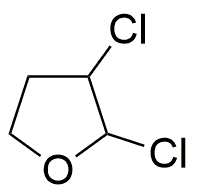2,3-Dichlorotetrahydrofuran is widely utilized in research focused on:
- Synthesis of Fine Chemicals: This compound serves as an important intermediate in the production of various fine chemicals, including pharmaceuticals and agrochemicals, due to its unique reactivity.
- Solvent Applications: It acts as a solvent for organic reactions, providing a stable environment for chemical processes, which is particularly beneficial in laboratories and industrial settings.
- Polymer Production: Used in the synthesis of polymers, it enhances the properties of the resulting materials, making them suitable for applications in coatings and adhesives.
- Research in Environmental Chemistry: Its properties allow researchers to study the degradation pathways of chlorinated compounds, aiding in the development of better environmental remediation strategies.
- Analytical Chemistry: This compound is employed as a standard in various analytical techniques, helping in the accurate quantification of related substances in complex mixtures.
Informations générales
Propriétés
Sécurité et réglementation
Applications
2,3-Dichlorotetrahydrofuran is widely utilized in research focused on:
- Synthesis of Fine Chemicals: This compound serves as an important intermediate in the production of various fine chemicals, including pharmaceuticals and agrochemicals, due to its unique reactivity.
- Solvent Applications: It acts as a solvent for organic reactions, providing a stable environment for chemical processes, which is particularly beneficial in laboratories and industrial settings.
- Polymer Production: Used in the synthesis of polymers, it enhances the properties of the resulting materials, making them suitable for applications in coatings and adhesives.
- Research in Environmental Chemistry: Its properties allow researchers to study the degradation pathways of chlorinated compounds, aiding in the development of better environmental remediation strategies.
- Analytical Chemistry: This compound is employed as a standard in various analytical techniques, helping in the accurate quantification of related substances in complex mixtures.
Documents
Fiches de données de sécurité (FDS)
La FDS fournit des informations de sécurité complètes sur la manipulation, le stockage et l’élimination du produit.
Spécifications du produit (PS)
Le PS fournit une description complète des propriétés du produit, notamment sa composition chimique, son état physique, sa pureté et les exigences de stockage. Il détaille également les plages de qualité acceptables et les applications prévues du produit.
Certificats d'analyse (COA)
Recherchez des certificats d'analyse (COA) en saisissant le numéro de lot du produit. Les numéros de lot et de lot se trouvent sur l'étiquette d'un produit, après les mots « Lot » ou « Lot de fabrication ».
Numéro de catalogue
Numéro de lot/série
Certificats d'origine (COO)
Ce certificat d'exploitation confirme le pays dans lequel le produit a été fabriqué, et détaille également les matériaux et composants utilisés et s'il est issu de sources naturelles, synthétiques ou autres sources spécifiques. Ce certificat peut être requis pour les douanes, le commerce et la conformité réglementaire.
Numéro de catalogue
Numéro de lot/série
Fiches de données de sécurité (FDS)
La FDS fournit des informations de sécurité complètes sur la manipulation, le stockage et l’élimination du produit.
DownloadSpécifications du produit (PS)
Le PS fournit une description complète des propriétés du produit, notamment sa composition chimique, son état physique, sa pureté et les exigences de stockage. Il détaille également les plages de qualité acceptables et les applications prévues du produit.
DownloadCertificats d'analyse (COA)
Recherchez des certificats d'analyse (COA) en saisissant le numéro de lot du produit. Les numéros de lot et de lot se trouvent sur l'étiquette d'un produit, après les mots « Lot » ou « Lot de fabrication ».
Numéro de catalogue
Numéro de lot/série
Certificats d'origine (COO)
Ce certificat d'exploitation confirme le pays dans lequel le produit a été fabriqué, et détaille également les matériaux et composants utilisés et s'il est issu de sources naturelles, synthétiques ou autres sources spécifiques. Ce certificat peut être requis pour les douanes, le commerce et la conformité réglementaire.


